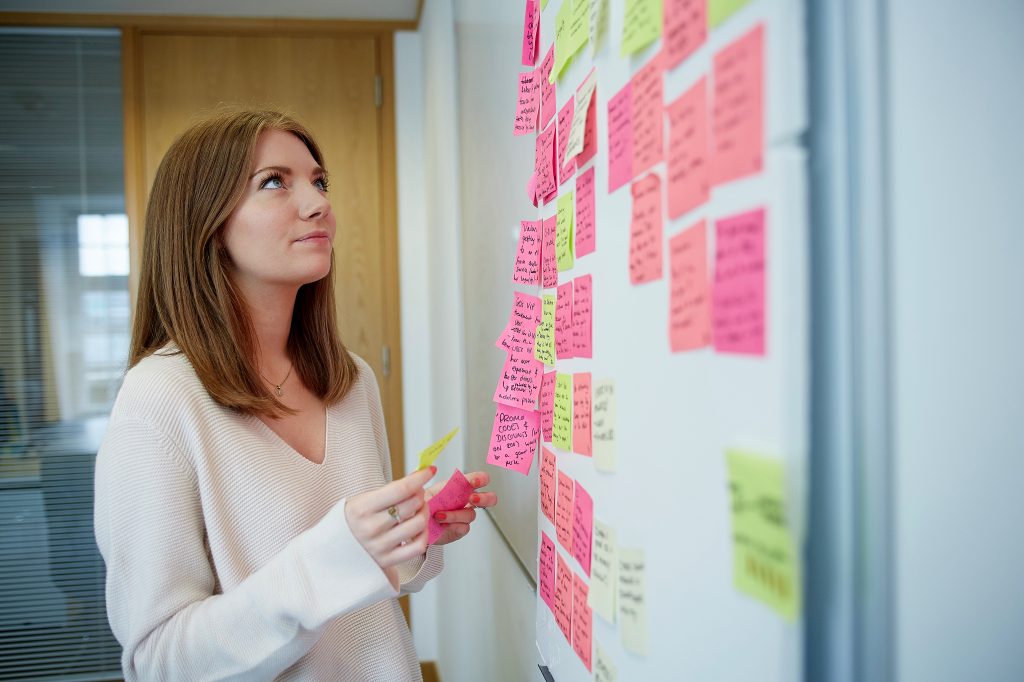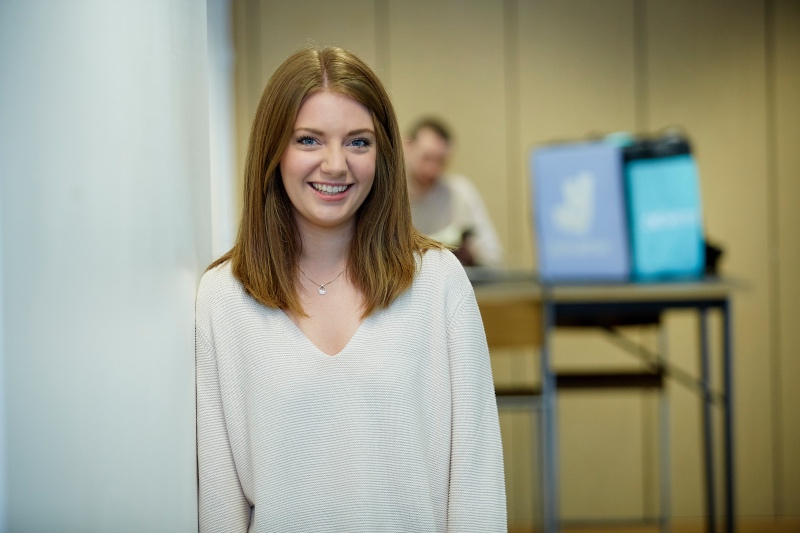In our latest UX Insider Interview, I chatted to Charlotte Clancy about the fast-paced world of UX at Deliveroo, and how her team have become such an integral part of the organisation.
Can you tell me a bit about your job title and responsibilities at Deliveroo?
I’m the User Research Lead, with a team of six people. But my role has changed a lot in the 18 months I’ve been here. When I joined I was the first researcher, so I was introducing UX as a discipline and helping all the teams here understand what it meant to have research as part of their process.
Then my role focused more on hiring a team, and now that we’ve got that in place I’m transitioning from spending most of my time doing research and some of my time managing, to thinking more about a strategy for my team and slightly less of my time doing research.
I work closely with product managers to help them think about how they can better use the researcher that they’ve got in their team. I’m the only lead who sits across all the teams, which means I’m often the only person who’s aware of what’s happening in different areas and can therefore bring them together when it’s relevant.
How does working at Deliveroo differ from your experience working at GDS?
I think the biggest difference is that here we spend most of our time doing research and we don’t really need to help the teams understand what they need to do off the back of it, because they’re all really engaged and empowered to make those changes, big or small. Because we’re always moving from project to project, we’ll often drop findings on a product manager or designer’s desk and leave them to run with it. But they take it all onboard and treat it as though they’ve done the research, which is great.
Whereas at GDS we’d spend more time communicating what we’d learned and helping people understand what they needed to do as a result. The other difference is just the speed at which we turn around work. The longest project we’ve ever done at Deliveroo was six weeks, but most of the time it’s a week or less.
I’ve made a deliberate effort to ensure we fit in with other people’s timescales.
How have you built that trust with other teams in the business?
Deliveroo is a very user-centred business. That means the conversations we have here are always user-centred and everyone’s really thankful that they can share their ideas and experiences with a researcher who can feed back based on their wider knowledge. We’re able to inform a conversation that is already happening rather than trying to start that conversation in the first place.
I’ve also made a deliberate effort to ensure we fit in with other people’s timescales. If you can give people the information that they need at the point that they need it then it’s much easier to make them want that as part of the cycle, as opposed to saying: “Hold everything up, in three weeks we’ll have what you need.” That’s when people will start ignoring you.
How do you define your users at Deliveroo?
One of the things that I think is most interesting about working here is that we have four different groups of users: customers, riders, restaurants and internal users. We give them all equal value. Another thing that we think about a lot are cultural differences, so internationally all four of those user bases can be quite different.
With our riders, the demographics can be totally different not even just by country but by city. For example in London they’ll often be professional scooter riders who are couriers full-time, whereas in Bristol you’ve got loads of students. One of the goals that the research teams have this year is to not always do research in London. That doesn’t necessarily mean going to another country, but at least going to another UK city.
Have you got any examples of the type of research questions you tackle?
Last quarter we looked at how people make decisions about choosing a restaurant when they order in from Deliveroo, compared to when they’re eating out. What validation do they need to know it’s a restaurant they want to eat at? What is the sense of occasion for eating out versus eating in; how does it differ and should it differ?
We wanted to explore whether there were things we should take from one experience to put into the other. So should we be encouraging our users to check TripAdvisor or restaurant reviews, or do they not need or want that from Deliveroo even if that’s what they’d do when eating out?

What are the biggest challenges that you’re facing in the next 12 months?
Probably the speed we’re growing at. Every autumn when the weather starts getting worse our orders go through the roof and we never know what’s going to be the limiting factor – as far as I understand every year it’s been different. So we’re always thinking about how we can future-proof ourselves. For research, a big thing is trying to understand where our service weak points are and how can we improve things for our riders, restaurants and customers to ensure we don’t have a blip as we grow.
The other side of that is how we deal with internal growth and making sure we communicate our research to everyone in the business who needs to know it. Staff numbers have increased across the board, so it’s not always easy to know who you need to share research with. I’m sure there are people who could benefit from what we’re doing but who we’re not reaching, so we need to find a solution to that as well.
I read an article that you wrote about prioritising research at Deliveroo. Can you summarise any learnings from that?
It’s quite interesting looking back on that because it’s totally changed, but in the way that I wanted it to. When I wrote that article there were just two researchers working with eight product teams, who were all working on completely different things and with completely different user groups. That meant we had to artificially prioritise – decide to do one thing over another – but in reality they were all of relative importance for the equivalent teams.
Now we prioritise research on a team level because our researchers are either embedded in a single team or across two or three teams – but if they’re across multiple teams it’s all for the same user group. That means cross-prioritising is nowhere near as difficult now, because your questions are all about one type of user, rather than having a question about riders, another about restaurants and another about customers that are all equally important.
We did a massive, more ethnographic piece of research where we went into kitchens and restaurants
Do you have an example of a project that you’ve worked on that you’re really proud of? Can you tell me about the impact it had?
We did a project with the restaurant product team around understanding what the needs of restaurants were in order to completely reimagine the restaurant app. The reason I’m proud of this project is because it went exactly how I imagined research would go in an ideal world.
We joined them on the project when they were in the early phases of figuring out the questions. Then we did a massive, more ethnographic piece of research where we went into kitchens and restaurants and talked to them about what working with Deliveroo was like and got them to show us the flow of what happens when an order comes in, in a theoretical way. But we also observed them over a busy period and watched how that differed, or didn’t, from what they’d told us.
It allowed us to really understand all of the needs that they had specific to the app, but also the other things that were getting in their way that could potentially be solved with technology. Off the back of that we distilled everything into a few key actions that we needed to encompass in the new app and worked really closely with the designer and product manager on iterative designs.
It was really interesting to see how the key needs that we identified at the beginning were true and also to follow the process so tightly that we were able to watch as the needs became more answered through each design. It was great to see how the metrics for the new app vs the old app completely diverged in terms of how long our riders were waiting at restaurants.
You’ve mentioned ethnographic and observational, but what research methods do you use the most?
As a team we’re very much empowered to pick whatever method we think would suit the problem best. We do a lot of usability testing but we also do an equal amount of more in-depth research and that’s where the methods vary a bit more. Often with restaurants, it’s just observation, with riders we do diary studies because it’s harder to go out and about with them and we’ve done diary studies with customers as well. We also do in-home observations with customers.
One cool thing we did was to get a group of five girls to come into a lab so we could watch the dynamics around a group deciding what to order. They bickered over the options for about 45 minutes before just drawing a piece of paper out of a wine glass. It was really interesting to see and I think it’s always good to experiment with new ways of trying to answer the problem.
What separates a good user researcher from a great one?
There are two things I think are quite rare and that I’d say make someone a great researcher. One is having a strategic attitude. That means not just thinking on an interface or tactical level, but thinking about how we can markedly change the service that we offer and what research we can do to enable that. The other thing that we need here is an extremely pragmatic approach in terms of timeframes, speed and agility to adapt to what is by far the fastest-paced place I’ve worked. Finding someone with a deep understanding of how you can apply research in a more strategic way, as well as the ability to pare that back when necessary can be hard.
What are the best and hardest parts of your role?
The best thing is the fact that I’ve never had a bad day at work. Every single day is so much fun and working somewhere that’s growing and changing as fast as we are means that my job is always changing and I can’t see myself getting bored. It’s such an interesting place to work with such difficult problems to solve. We’re redefining a lot of industries that were quite established and that’s really exciting.
But it’s also great to be working in a place where so many people are so enthusiastic, clever and motivated to make changes. It’s really cool how people will just act upon your ideas.
The hardest part of my job is also what makes it good, which is the speed things change at.
You clearly love what you do. How do you summarise your love for UX?
I think specifically with research it’s being able to craft conversations with people and get the answers that you need without being so explicit that those answers are invalidated. It’s about having to be smart about the way that you get the answers to your problem and being able to abstract that back into solutions that you can apply to how you improve the products or services that you’re building. That is what I love about research in general. What I love about it here is how interconnected all the different parts are and because we’re doing real-time logistics it’s really fast-paced.
we’re building kitchens where there aren’t particularly good restaurant options but there is an addressable market of people who would be interested in ordering from us
What do you think will be different in five years in the way we order takeaway?
I think Deliveroo and similar services have changed how people perceive ordering food. But I feel like there’s a limit to how far we can go in terms of reach and price, so they’re both things that I think in five years will have significantly changed.
We’ve started tackling the issue of reach with Deliveroo Editions. Basically, we’re building kitchens where there aren’t particularly good restaurant options but there is an addressable market of people who would be interested in ordering from us. So we’re starting to bridge the first problem by creating supply wherever there’s demand. I’m really excited to see where that goes in five years because even in one year we’ve gone from none to 20 and we’re still expanding.
Price is the second one I mentioned, but that’s not something that we’ve started thinking about to the same degree as reach. At some point, we’ll have to look at how can we help people have options that mean it’s affordable to do it more often.
Once both of those are in place it will shift to making sure that we’re ethical about what food we offer, because if you’re getting to the point that it’s something people are using regularly you want to make sure you’re contributing to their health in a positive rather than a negative way.
There’s a lot of talk about conversational commerce with people looking at ways to order food in a more conversational way, how do you think that might affect this industry?
In terms of what we’ve seen in research, where one of the biggest sticking points is making a decision on what to order, I feel as though the real benefit of a chat UI could be something that could help in scenarios where you can ask a question like: “We’re ordering for ten people and one is vegetarian, can you suggest what we could order?” Other than that I feel like it would be used more as a novelty rather than to solve a problem.
The map you have on Deliveroo demonstrates great transparency, but is there a negative side to it as well?
There can be and we’ve recently redesigned this element of the app. In our research people come up with all kinds of explanations as to why their rider isn’t moving – such as that they’re having a break. In reality, it’s more likely to be that they’ve lost signal or are stuck in traffic. But our customers don’t know that.
Customers love the map, but actually it tends to create anxiety. It’s an easy thing to fix, but the map has always been seen as a big selling point within the organisation because it empowers people to know everything that’s going on with their order. It’s been a really long journey to convince everyone that even though customers say they love it, that doesn’t mean it’s the best experience we can provide.
————
Thanks for reading. If you would like to be interviewed, or you’d like us to interview anyone in particular please get in touch.
You can find Charlotte on Twitter: @charlotteclancy, or check out more in our UX Insider series



